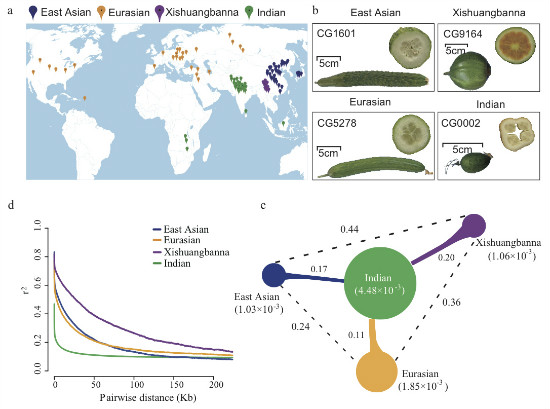分享到
A map of genome variation reveals cucumber’s evolutionary history and pave way for future improvement
Vegetables are essential to our health and wellbeing. However, we know little about the evolutionary path of these crops from the wildness and to our dining tables. The cucumber, a major vegetable crop consumed worldwide, was originated from India as a bitter herb medicinal plant.
In 2009, an international team sequenced the genome of domesticated cucumber. Four years later, the same team sequenced 115 diverse cucumber lines and produced a single-nucleotide resolution map of cucumber genome variation (Fig. 1).

Fig. 1: Characterization of cucumber populations.

Fig. 2: identification of a key mutation responsible for the accumulation of β-carotene in the fruit of the Xishuangbanna cucumbers.
In 2009, an international team sequenced the genome of domesticated cucumber. Four years later, the same team sequenced 115 diverse cucumber lines and produced a single-nucleotide resolution map of cucumber genome variation (Fig. 1).

Fig. 1: Characterization of cucumber populations.
“Genetic variation provides the material for extensive studies on natural selection, domestication, adaption, migration and various traits of cucumber, an economically important vegetable crop,” says Prof. Huang Sanwen, a scientist from the Institute of Vegetables and Flowers of the Chinese Academy of Agricultural Sciences (IVF-CAAS), who lead the international team of 28 researchers to complete the study, online published in Nature Genetics on 20 October 2013.
A total of 3,305,010 single nucleotide changes, and 336,081 insertions or deletions of up to five nucleotides in length were captured in the genomes of the population. Analyses of these variants revealed one ancestral, wild group and three derived, cultivated groups. Comparison of the genomes of the wild and cultivated cucumbers identified 112 genome regions (containing about 2,000 genes) putatively under human selection that lead to the genetic variations of today’s cucumber varieties, including the genetic region that made the ancient cucumber extremely bitter.
A total of 3,305,010 single nucleotide changes, and 336,081 insertions or deletions of up to five nucleotides in length were captured in the genomes of the population. Analyses of these variants revealed one ancestral, wild group and three derived, cultivated groups. Comparison of the genomes of the wild and cultivated cucumbers identified 112 genome regions (containing about 2,000 genes) putatively under human selection that lead to the genetic variations of today’s cucumber varieties, including the genetic region that made the ancient cucumber extremely bitter.

Fig. 2: identification of a key mutation responsible for the accumulation of β-carotene in the fruit of the Xishuangbanna cucumbers.
Not only zooming into the difference between the wild and cultivated cucumber, the team also paid attention to the difference among the three cultivated groups, an aspect that was almost ignored. “New alleles from a separate cultivated group represent low-hanging fruit for crop improvement, as their linkage with most unfavorable genes should have been eliminated by human selection.” emphasizes Huang. By comparing different groups, the researchers discovered a natural genetic variant in a beta-carotene gene (Fig. 2) that could be used to breed cucumbers with enhanced nutritional benefits.
“The knowledge and resources will not only facilitate further investigation of how vegetables in our kitchen evolved from the wilderness, but also provide the basis to design diagnostic tools for practical breeding,” explains Huang. All sequence data from the study is available to the public.
For more information visit the complete study at:
http://www.nature.com/ng/journal/vaop/ncurrent/abs/ng.2801.html (doi:10.1038/ng.2801)
For the cucumber genome paper published by the same team in 2009:
http://www.nature.com/ng/journal/v41/n12/abs/ng.475.html
More information about the research team:
“The knowledge and resources will not only facilitate further investigation of how vegetables in our kitchen evolved from the wilderness, but also provide the basis to design diagnostic tools for practical breeding,” explains Huang. All sequence data from the study is available to the public.
For more information visit the complete study at:
http://www.nature.com/ng/journal/vaop/ncurrent/abs/ng.2801.html (doi:10.1038/ng.2801)
For the cucumber genome paper published by the same team in 2009:
http://www.nature.com/ng/journal/v41/n12/abs/ng.475.html
More information about the research team:
Annex :
Latest News
-
 Apr 18, 2024Opening Ceremony of the Training Workshop on Wheat Head Scab Resistance Breeding and Pest Control in Africa Held in CAAS
Apr 18, 2024Opening Ceremony of the Training Workshop on Wheat Head Scab Resistance Breeding and Pest Control in Africa Held in CAAS -
 Apr 03, 2024IPPCAAS Co-organized the Training Workshop on Management and Application of Biopesticides in Nepal
Apr 03, 2024IPPCAAS Co-organized the Training Workshop on Management and Application of Biopesticides in Nepal -
 Mar 28, 2024Delegation from the School of Agriculture and Food Science of University College Dublin, Ireland Visit to IAS, CAAS
Mar 28, 2024Delegation from the School of Agriculture and Food Science of University College Dublin, Ireland Visit to IAS, CAAS -
 Mar 25, 2024Director of World Food Prize Foundation visited GSCAAS
Mar 25, 2024Director of World Food Prize Foundation visited GSCAAS -
 Mar 20, 2024Institute of Crop Sciences (ICS) and Syngenta Group Global Seeds Advance Collaborative Research in the Seed Industry
Mar 20, 2024Institute of Crop Sciences (ICS) and Syngenta Group Global Seeds Advance Collaborative Research in the Seed Industry
